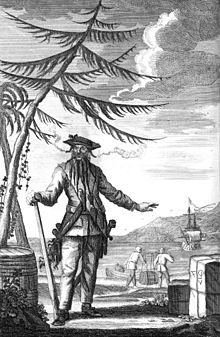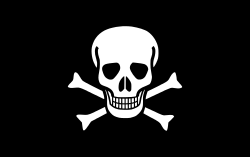 |
| www.helenhollick.net |
You would think that pirates, being pirates, would have either straightforward memorable names or ‘Jolly Roger’ type names wouldn’t you? I mean you have Captain Hook from Peter Pan (appropriate,) Captain Pugwash from – well, Captain Pugwash. Blackbeard, Calico Jack, Black Sam…
And many of their ships had names with variants upon the theme of Revenge, Rover, or Adventure. (I presume that there was no ‘Suggested Ships’ Names’ books in the early eighteenth century – and pirates didn’t have much of an imagination.)
And many of their ships had names with variants upon the theme of Revenge, Rover, or Adventure. (I presume that there was no ‘Suggested Ships’ Names’ books in the early eighteenth century – and pirates didn’t have much of an imagination.)
Black Sam Bellamy was called ‘Black Sam’ because of:
1. His black coat
2. His black hair
3. His black ribbon, which he used to tie back his black hair
Take your pick
of which one you fancy.
‘Blackbeard’ was actually Edward Teach. Or Tatch. Or Thatch. (When
looking into the matter of pirates you soon come to realise that there are
quite a few maybes, might-haves, probablies and perhapses.) The difference between
Blackbeard’s name could be explained because it is believed that he might have
(see… what did I tell you?) originated from Bristol, so would have had a
distinct, strong West Country accent, pronouncing his name as something like ‘Taaa…ch’.
Oh and yes, he was famous for his black
beard.
 |
| Blackbeard |
‘Calico Jack Rackham’ was so-called because he (Jack Rackham) loved wearing
calico.
 |
| Calico Jack Rackham |
As for the Jolly Roger, the popular name for the familiar pirate flag,
we (again) are not certain of its origin. The best theory is that it comes from
the French Jolie Rouge. But there’s
no written or verbal source to confirm this, and as most of the early pirates
started out as privateers with a Letter Of Marque, which was a legal license-to-kill
or plunder the enemy – Spain and France – it seems odd that French words would have been
eagerly used. It’s just as possible that the first (now unknown) pirate who
flew a variation of the skull and crossed-bones flag was a jolly chap called
Roger.


My own Jesamiah Acorne was a name I made up while thinking about
the idea for Sea Witch while walking
along a rain-drizzled Dorset beach (see
the full story HERE if you don’t already know it.)
A friend (and now my editor) Nicky G. mentioned something
quite interesting while reading through my recently published Pirates : Truth And Tales…
Stede Bonnet was not a very successful pirate. (Understatement. He
was useless.) ‘How did he pronounce his name?’ Nicky asked.
 |
| Buy the Book (US pre-order) |
Answer: no idea. But it led
to an interesting conversation.
Bonnet as in a Jane Austen lace-trimmed bonnet? (Not very piratical!) Or did he say ‘Bonnay’?
I am reminded of the UK sit-com Keeping Up Appearances where the lead character Hyacinth Bucket
calls herself Hyacinth Bouquet.
Very recently my dear friend, John F. Millar who runs a fabulous 'Colonial Style' B & B in Williamsburg, Virginia, came across something interesting about the pirate Thomas
Tew:
Tew went on only two expeditions. He came back from the
first a very rich man, but did not return from the second. He is known as the
‘Rhode Island Pirate’, as it is widely believed that his family settled there
in the early 1640s. Allegedly, he was married with two daughters.
Moving to Bermuda in 1691 he engaged in government-backed
privateering and obtained his Letter of Marque in 1692. His mission was to
attack and destroy a French territory in the Gambia, West Africa. After a few
days at sea, Tew turned to piracy telling his crew that it would be more
profitable than blasting away at a few French buildings. They sailed to the Red
Sea, taking a ship heading from India in 1693. With their victim offering no
resistance Tew’s men ransacked the hold and acquired treasure worth something
in the region of £100,000 (add a couple of 0s for today’s equivalent!) They returned
home in the spring of 1694. Tew paid off the men who had sponsored him and
pursued an amicable friendship with the Province of New York Governor.
 |
| Thomas Tew relates his exploits to Gov. Fletcher of New York. Painting by Howard Pyle |
By winter that year, Tew sought another Letter of Marque and
sailed off again with between thirty to forty men, increasing the crew to
nearer sixty when he reached Madagascar. At the Bab-el-Mandeb Strait, the
entrance to the Red Sea, Tew came across several more pirates all with the same
intention, one of them being Henry Every. They joined forces and in either June
or September 1695 came across a Mughal convoy.


Tew attacked one of the ships, the Fateh Muhammed, and in the battle that followed was killed by a
cannon ball: a direct hit to his belly which disembowelled him. Shocked and
disheartened his crew surrendered. One version of the tale states that Henry
Every caught up, captured the Fateh
Muhammed and freed the men held prisoner in the hold, while another claims
that those who had not been immediately executed died in an Indian prison.
Tew’s resting place is unknown as he would have been buried at sea. Tew’s family
is rumoured to have lived a pleasant life of luxury from his first plundered
fortune.
Now, like me, I assume you’ve read the above pronouncing ‘Tew’ to
sound like ‘Pew’ - the benches you sit on in church, or ‘phew’ or dew as in morning dew.
Well, apparently not! It is Tew to rhyme with ‘sew’ or ‘go’ or ‘no’ or toe...
call back Friday for the new Novel Conversations series!




Yep - I read it as 'Tew' rhyming with 'pew'! But of course, there is no better name than Jesamiah Acorne, though, in retrospect, you might have spelled his first name 'Jesamiar' so he could always add," ....with an aaaarrrr". I'll get me coat ...
ReplyDeleteGrrrrroan.... LOL
Delete